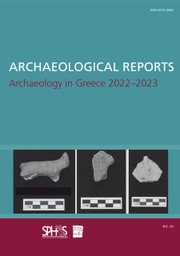No CrossRef data available.
Article contents
Central Greece and the Peloponnese (Archaic to Roman)
Published online by Cambridge University Press: 08 December 2014
Extract
The much shorter Archaiologikon Deltion for the single year of 2005 invariably offers far fewer reports on the work of the Archaeological Service than the four-year volume with which we were presented last year. This, in itself, is no bad thing, although the geographical and chronological balance generated by such a large dataset is notable by its absence. This unevenness is, as ever, partially offset by the publication of fieldwork, although certain areas maintain a far more visible archaeological presence than others. This is particularly true for the northeastern Peloponnese, which has, in recent years, been the recipient of an almost unparalleled focus of both research and rescue excavation; a fact reflected in the significant contribution made to this year's report by the edited proceedings of the conference The Corinthia and the Northeast Peloponnese: Topography and History from Prehistoric Times until the End of Antiquity (Kissas and Niemeier 2013). A total of 56 individual papers provide details on sites that range in date from the Neolithic to the Byzantine period. A great strength of this collection lies in the contribution of so many current and former staff of the Archaeological Service, and, of the numerous papers that engage directly or indirectly with the archaeology of the Archaic to Roman period, several are discussed in greater depth in the course of this report. A complementary Hesperia supplement detailing the current state of prehistoric and historic research on the Corinthian Isthmus is due to appear before the end of the year (Gebhard and Gregory forthcoming), as is a study of material from Henry Robinson's 1961–1962 excavation in the North Cemetery (Slane forthcoming). The study of religious practice during the Classical period benefits from the publication of the first volume of material from excavations conducted by the Canadian Institute in Greece between 1994 and 2001 in the Sanctuary of Athena at Stymphalos (Schaus 2014a), while the consolidation of synthetic regional studies and individual site reports within Villae Rusticae: Family and Market-oriented Farms in Greece under Roman Rule (Rizakis and Touratsoglou 2013) will no doubt ensure that it becomes a standard text for the study of the rural economy of Roman Greece (see Stewart, this volume).
- Type
- Archaeology in Greece 2013–2014
- Information
- Copyright
- Copyright © Authors, the Society for the Promotion of Hellenic Studies and the British School at Athens 2014




